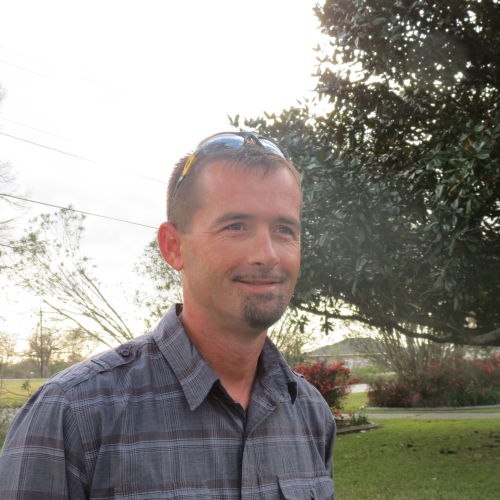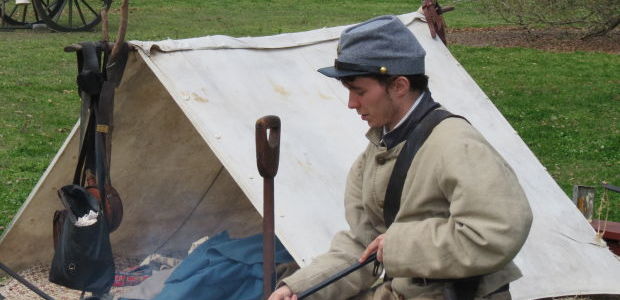
Drug Court success Story; For one man, a life is restored
March 5, 2013Where’s John Arnold?
March 5, 2013Standing in the shade of a graceful live oak on a chilly Saturday morning, Lawrence Arceneaux III adjusted the leather powder-holder on the waist of coarse cotton and wool uniform trousers.
As a freshman at Nicholls State University, he is an emblem of Louisiana’s future. But at the mock Confederate camp on property once owned by a former U.S. Supreme Court justice and soldier, he served as a striking living picture of the past. The effect was made haunting by the youthfulness he shares with so many who served on both sides of the bloodiest conflict in U.S. history.
“It is a tremendous experience to relive what my ancestors lived, it helps me to see what things were like through their eyes,” said Arcenaux, who is a history major at Nicholls.
For him and other members of the Hellfire Stew Mess/Bouanchaud’s Battery re-enactment group, last weekend’s living history event was an opportunity to share knowledge of and reverence for the past, at the Edward Douglas White Historic Site on La. Highway 1 in Thibodaux. Unlike many other re-enactment groups, the battery’s members do not commemorate a specific event, or do a live-action replay of a specific battle or skirmish.
“We choose not to designate our group with the name of an original regiment or company in order to allow for variety in our impressions, and to facilitate our group’s consolidation with larger units at re-enactment events,” said Hellfire spokesman Denis Gaubert, a Thibodaux attorney, historian and long-time participant in war period commemorations.
Highlights of the encampment included cooking in an outbuilding on the site, an open campfire near pitched tents and artillery demonstrations employing the group’s reproduction of a 12-pound Napoleon cannon.
As Arceneaux mingled with other re-enactors who, like himself, were dressed in period uniforms and had spent the weekend’s nights warding off an overnight chill that had dipped into the 30s, Gaubert greeted visitors who came by to soak up some of what the group had to offer, seated at a display table featuring real and reproduction period pistols, swords and memorabilia. For Gaubert, the re-enactments and attention to history are more than a mere academic exercise. Four of his ancestors were Confederate enlisted men, all of whom volunteered from communities in Lafourche Parish.
“I’ve wanted to come for years,” said Houma paramedic John Jackson, who toured the exhibits with his 4-year-old son, Christopher, in tow.
Christoper liked the cannon and the swords.
The Hellfire group is made up of Civil War aficionados from various communities in the Tri-parish area. The camp-out has become a long-standing annual event, sponsored in part by the Louisiana Department of Culture, Recreation and Tourism under Lt. Gov. Jay Dardenne.
While not as well-remembered as the sites of major battles at Gettysburg, Shiloh and other shrines further north, Lafourche, Terrebonne, St. Mary and surrounding parishes were sites of important naval and land battles and skirmishes, many related to federal attempts to open the Mississippi River. Much of the local activity, according to historians, involved support of Confederate troops attempting to fend off the siege. This year marks the 150th anniversary of the Battle of Lafourche Crossing, fought at a site just outside Thibodaux where 48 federal troops and 219 of the CSA were killed.
Skirmishes occurred up and down Bayou Lafourche in the local area, where journals of federal troops indicate widespread taking of pigs and other animals as they marched.
That was one reason, Gaubert surmises, why the support for guerilla Confederates and other CSA troops was so high in the region.
Johnny Authement, a founder of Hellfire, who also camped out for the weekend at the White property, shares a story about one of his ancestors in the area who, being too young to fight, helped the family out by hiding their mule in the swamps when federals were near, to prevent it from being taken.
The ability to share such stories is one of the driving forces behind participation of people like Arceneaux and Gaubert.
“I take the responsibility of telling their stories seriously because they are not here to speak for themselves,” Gaubert said of the opportunity to speak of his ancestors. “I have to speak for him, to communicate what they expressed back then … It was, as it usually is, very gratifying and we feel we accomplished something. It is always enjoyable to speak with people who are genuinely interested in history. It is especially gratifying when you speak with someone that doesn’t know a lot about the history and suddenly learns, and you maybe kindle a spark in them to learn more.”
Re-enactors spent chilly nights Friday and Saturday camping at the E.D. White site in Confederate uniforms. Below at left, John Jackson of Houma looks on as his son Christopher marvels at the sword displayed by Confederate re-enactor Johnny Authement at the E.D. White historic home. Below at right, re-enactor Lawrence Arceneaux III talks about his love of history.









